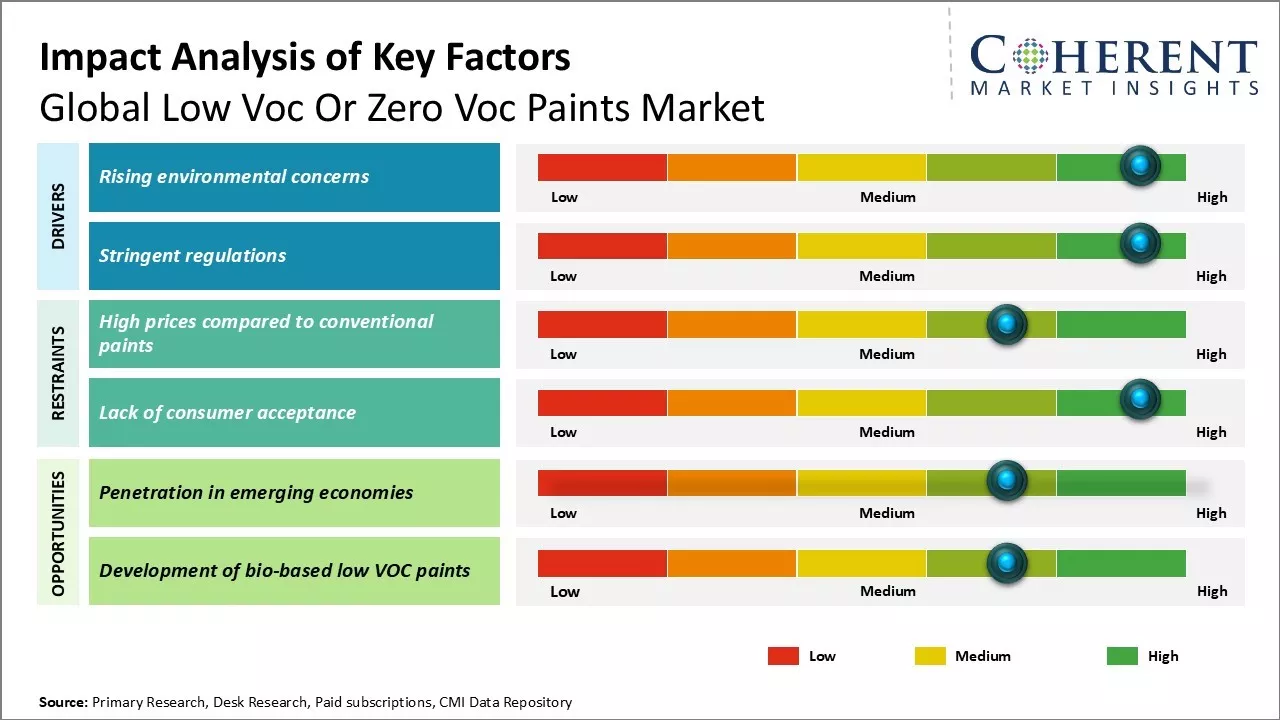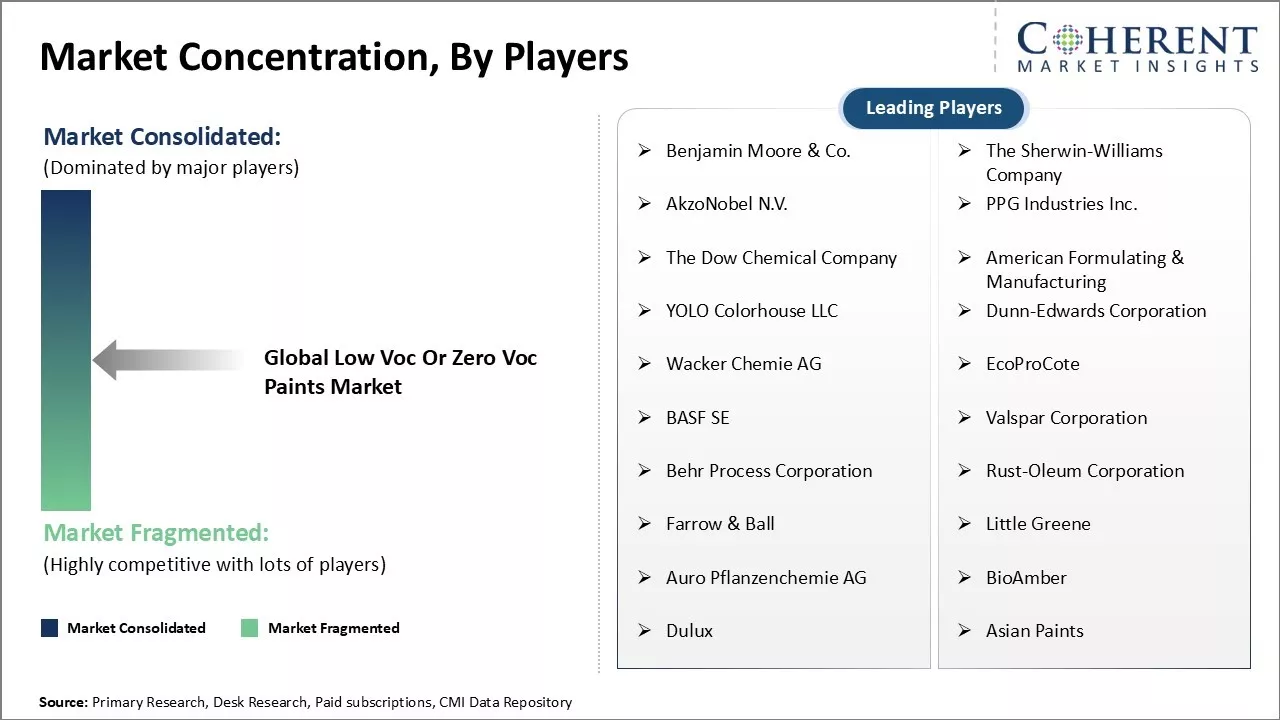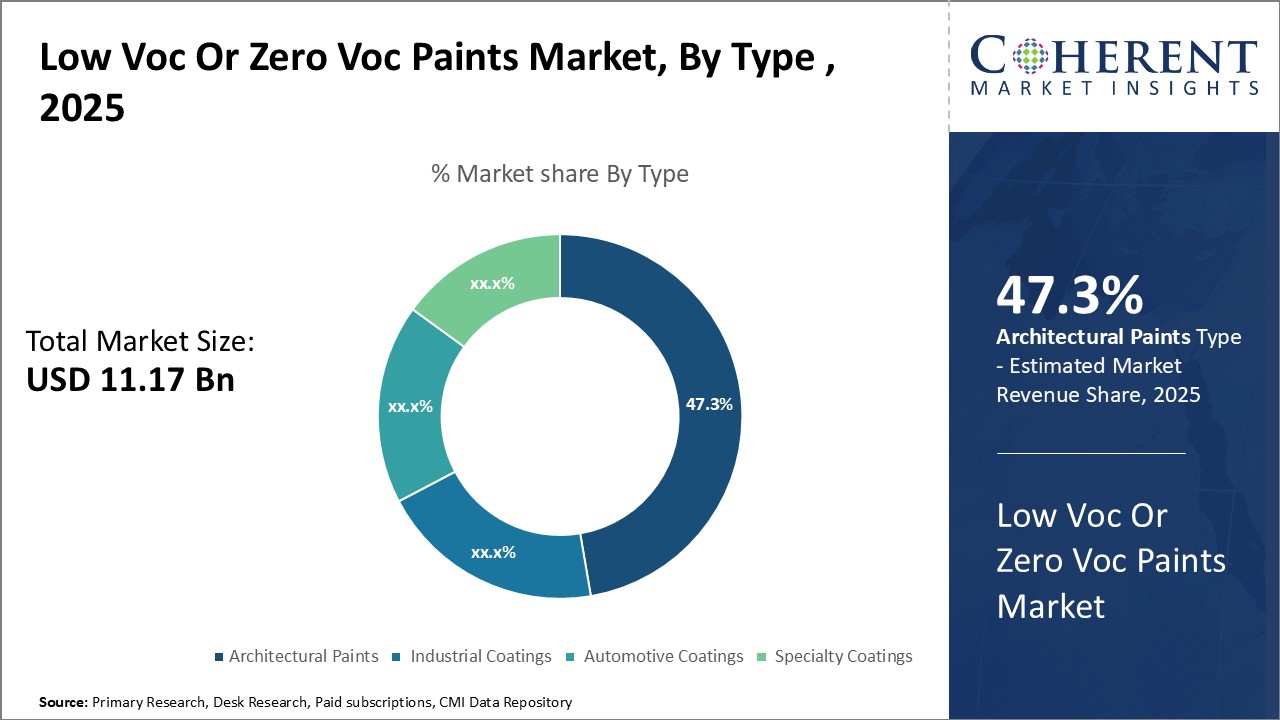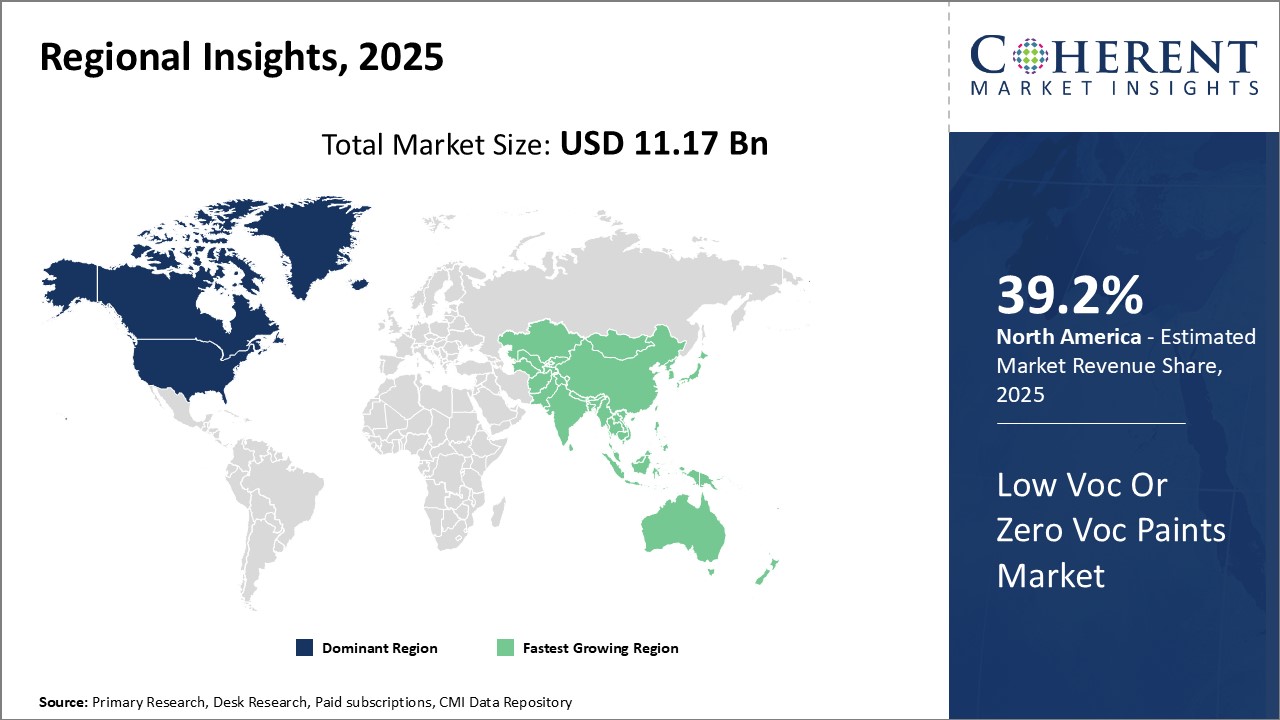The Global Low Voc Or Zero Voc Paints Market is estimated to be valued at USD 11.17 Bn in 2025 and is expected to reach USD 17.83 Bn by 2032, exhibiting a compound annual growth rate (CAGR) of 6.9% from 2025 to 2032.

Discover market dynamics shaping the industry: Download Free Sample
Strict environmental regulations regarding VOC emissions and awareness about health hazards of VOC are driving the demand for low and zero VOC paints globally.
Rising environmental concerns
With greater awareness about the impact of the products we use on the environment, people are increasingly switching to more eco-friendly alternatives. The chemicals used in traditional paints are a major concern as they emit volatile organic compounds (VOCs) into the air both during application and off-gassing over time. VOCs have been linked to various negative health effects like headaches, eye and throat irritation, and may also contribute to the formation of ground-level ozone. For those concerned about indoor air quality, low, or zero VOC paints offer a sustainable solution.
Customers are more invested in making greener choices now. Millennials in particular want to purchase from brands that are purpose-driven and committed to reducing their environmental footprint. By opting for low VOC paints, consumers can decorate their homes with products that do not compromise the health and well-being of their families. This growing mindset threatens the market position of conventional paint makers who have not taken adequate steps to curb emissions. Forward-thinking manufacturers are capitalizing on the trend by offering low or no VOC paint lines. Their eco-friendly formulations appeal to the changing values of shoppers who want to balance style with sustainability.

Get actionable strategies to beat competition: Download Free Sample
Stringent regulations
As awareness rises on the adverse effects of VOC emissions, regulatory bodies are placing stricter limits on the allowable VOC content in paints and architectural coatings. Authorities want to cut down on smog generation and other forms of air pollution caused by everyday consumer goods. In the EU and North America, the maximum permitted levels have reduced significantly over the past decade. Nations are even banning certain toxic chemicals previously used as solvents, pigments, or preservatives in standard paints. Companies must reformulate their product ranges within stipulated timeframes or risk penalties.
Tightening standards pose a compliance challenge for those still heavily reliant on solvent-borne technologies. Transitioning entire production processes and supply chains to water-borne solutions requires extensive research and capital investments. However, non-compliance is not a viable long term business strategy either. Those proactively developing innovative low or no VOC product portfolios gain a strong competitive advantage. They will be well positioned to meet future emission standards without costly alterations to operations. Leading the shift to greener alternatives also allows brands to positively shape the policy dialogue and enjoy first-mover benefits. Over time, only the most eco-conscious players left in the market will be able to continue serving dynamically evolving regulations and customer priorities worldwide.
Key Takeaways from Analyst:
The global low VOC or zero VOC paints market is expected to witness strong growth over the next decade. Major drivers of this growth include stringent environmental regulations regarding VOC emissions from paints and coatings in developed markets across North America and Europe. Many countries have established strict limits on the VOC content allowed in various paint types which is increasing the demand for low and no-VOC alternatives. Additionally, health consciousness among consumers is raising awareness about the harmful effects of VOCs, propelling a shift towards greener paint options.
The Asia Pacific region, particularly China and India, represents the largest and fastest growing market globally. With improving environmental standards in developing Asian countries, the regulatory push towards low-VOC products is anticipated to intensify in the coming years. Though higher costs may pose a challenge for mass adoption, growing concerns over air quality issues in densely populated urban centers provides lucrative opportunities.
Green building trends and sustainable construction practices also serve as major opportunities. Incorporating low-VOC paints enables builders and developers to obtain essential green certifications for their projects. This acts as a value addition that helps capture environment-conscious customers. Raw material advancements enabling improved formulations while reducing VOCs levels without compromising on performance attributes could further support market expansion.
Market Challenges: High prices compared to conventional paints
One of the key challenges currently being faced by the global low VOC or zero VOC paints market is the relatively higher prices of these products as compared to conventional solvent-based paints. While low and zero VOC paints ensure better indoor air quality and are more environmentally sustainable, their production process tends to be more complex and expensive. Stringent regulations surrounding VOC emissions require manufacturers to invest heavily in advanced production technologies and utilize premium quality, eco-friendly ingredients in their formulations. This translates to significantly higher manufacturing costs. Further, the lack of economies of scale at present also pushes up the prices to some degree. Many consumers, especially in cost-sensitive developing nations, are hesitant to pay this premium and opt for cheaper conventional paints instead. This price gap needs to be reduced further for low VOC paints to achieve mass acceptance in the global decorative and industrial paints industry.
Market Opportunities: Penetration in Emerging Economies
One of the major opportunities available for the global low VOC or zero VOC paints market is the vast potential for penetration into emerging economies. While regulations are still evolving in most developing countries, environments standards and consumer awareness about indoor air quality are steadily rising. The growing middle class population in nations such as China, India, Brazil, and other Asia Pacific and Latin American countries will potentially drive the demand for premium low emission paints in the coming years. These regions are also expected to witness robust industrial and infrastructure growth, thus opening up opportunities across the architectural and industrial coatings segments. Aggressive marketing campaigns, introduction of economical product ranges, and localization of manufacturing facilities could help reduce prices and drive wider acceptance of low VOC paints in emerging markets going forward. Tapping into these high growth avenues will be crucial for market leaders to sustain double-digit expansion rates over the next five years.

Discover high revenue pocket segments and roadmap to it: Download Free Sample
Insights by type: Home Improvement Drives the Demand for Architectural Paints
In terms of type, architectural paints is expected to contribute 47.3% share of the market in 2025, owing to the growing home improvement industry. The architectural paints segment caters mainly to residential applications and benefits tremendously from ongoing trends in the housing market. Homeowners regularly opt to paint both the interiors and exteriors of their homes to protect surfaces and improve aesthetics. The easy application and wide color selection of architectural paints make them a preferred choice for do-it-yourself projects and professional contractors alike. Population growth coupled with rising incomes have bolstered demand for housing in recent years. This has spurred both new construction and existing home renovations, fueling the consumption of architectural paints. Additionally, shortening replacement cycles encourage more frequent repainting work. Architectural coatings offer an affordable and low-effort way for homeowners to refresh or transform the look and feel of their living spaces. With people spending more time at home due to remote working and learning trends, architectural paint sales remain robust.
Insights by application: Growing environment-friendly paints demand
Low Volatile Organic Compounds (VOC) and zero VOC paints are increasingly popular in the residential sector. The residential segment is projected to capture a significant share of 37% in 2025. These environment-friendly paints are favored for their minimal impact on indoor air quality, making them ideal for homes where families, including children and pets, reside. Their use reduces exposure to harmful chemicals, promoting a healthier living environment. Additionally, low and zero VOC paints offer excellent performance, including good coverage, durability, and a variety of finishes, appealing to homeowners seeking both aesthetics and safety. As sustainability becomes a more prominent consideration for consumers, the demand for these paints continues to grow, aligning with broader trends toward eco-friendly building practices and materials.
Insights by distribution channel: Changing Preferences Drive the Online Retail Segment
In terms of distribution channel, the online retail segment is expected to capture 34.9% share of the global low voc paints market in 2025, due to evolving consumer purchasing habits. Unlike traditional brick-and-mortar suppliers, e-commerce platforms provide buyers with unparalleled convenience in researching and purchasing paint products from the comfort of their homes. They round-the-clock access to a wide variety of brands and customized service offerings online. The transparency of reviews and ratings also helps customers shortlist suitable options more efficiently. Moreover, with the ongoing pandemic spurring greater adoption of contactless commerce, people increasingly turned to virtual retail channels even for routine purchases like paints. Established online platforms as well as D2C brands leverage telemarketing, social media, and targeted ads to promote their green, low-chemical offerings directly to environmentally conscious consumers. Select players even provide customized color consultation and project guidance services online. Backed by free delivery, easy returns, and promotional deals, the zero-contact online retail model has become the preferred shopping method for many individuals buying low VOCs paints.

Need a Different Region or Segment? Download Free Sample
North America currently dominates the global low VOC or zero VOC paints market. The region is expected to hold 39.2% of the market share in 2025. The presence of stringent environmental regulations promoting the use of green products is driving significant adoption of low VOC paints across various end-use industries such as construction, automotive, and packaging in the region. Majority of the leading paints and coatings manufacturers are headquartered in the U.S. and Canada and have established widespread distribution channels across the region. This allows them to cater to the growing demand for low VOC paints from both commercial and individual consumers. Moreover, growing awareness about indoor air quality and its impacts on health is further augmenting the market growth in North America.
The Asia Pacific region is expected to witness the fastest growth in the low VOC or zero VOC paints market during the forecast period. Rapid urbanization and infrastructure growth are leading to an exponential increase in new construction activities across the emerging nations of China, India, Indonesia, and Vietnam. This is generating substantial demand for low VOC paints and coatings. At the same time, improving standards of living have increased consumer spending on home décor and remodeling in the region. However, price sensitivity remains high in the Asia Pacific market as compared to developed regions. Therefore, local and regional manufacturers are focusing on cost competitiveness through emphasis on raw material sourcing and R&D to make affordable low VOC products. Initiatives by governments of several Asian countries to lower VOC emission levels from the paints and coatings industry are also driving wider adoption. This has encouraged international brands to expand their footprint to leverage untapped growth opportunities.
Low Voc Or Zero Voc Paints Market Report Coverage
| Report Coverage | Details | ||
|---|---|---|---|
| Base Year: | 2024 | Market Size in 2025: | USD 11.17 Bn |
| Historical Data for: | 2020 To 2024 | Forecast Period: | 2025 To 2032 |
| Forecast Period 2025 to 2032 CAGR: | 6.9% | 2032 Value Projection: | USD 17.83 Bn |
| Geographies covered: |
|
||
| Segments covered: |
|
||
| Companies covered: |
Benjamin Moore & Co., The Sherwin-Williams Company, AkzoNobel N.V., PPG Industries Inc., The Dow Chemical Company, American Formulating & Manufacturing, YOLO Colorhouse LLC, Dunn-Edwards Corporation, Wacker Chemie AG, EcoProCote, BASF SE, Valspar Corporation, Behr Process Corporation, Rust-Oleum Corporation, Farrow & Ball, Little Greene, Auro Pflanzenchemie AG, BioAmber, Dulux, and Asian Paints |
||
| Growth Drivers: |
|
||
| Restraints & Challenges: |
|
||
Uncover macros and micros vetted on 75+ parameters: Get instant access to report
*Definition: The global low VOC or zero VOC paints market consists of architectural coatings that contain either low or zero levels of volatile organic compounds (VOCs) which are solvents that contribute to air pollution and health issues. Low/zero VOC paints are increasingly in demand due to tighter regulations on VOC emissions from painting projects. They provide builders and homeowners with more environment-friendly alternatives to traditional solvent-based paints that emit higher levels of VOCs.
Share
Share
About Author
Yash Doshi is a Senior Management Consultant. He has 12+ years of experience in conducting research and handling consulting projects across verticals in APAC, EMEA, and the Americas.
He brings strong acumen in helping chemical companies navigate complex challenges and identify growth opportunities. He has deep expertise across the chemicals value chain, including commodity, specialty and fine chemicals, plastics and polymers, and petrochemicals. Yash is a sought-after speaker at industry conferences and contributes to various publications on topics related commodity, specialty and fine chemicals, plastics and polymers, and petrochemicals.
Missing comfort of reading report in your local language? Find your preferred language :
Transform your Strategy with Exclusive Trending Reports :
Frequently Asked Questions
Joining thousands of companies around the world committed to making the Excellent Business Solutions.
View All Our Clients